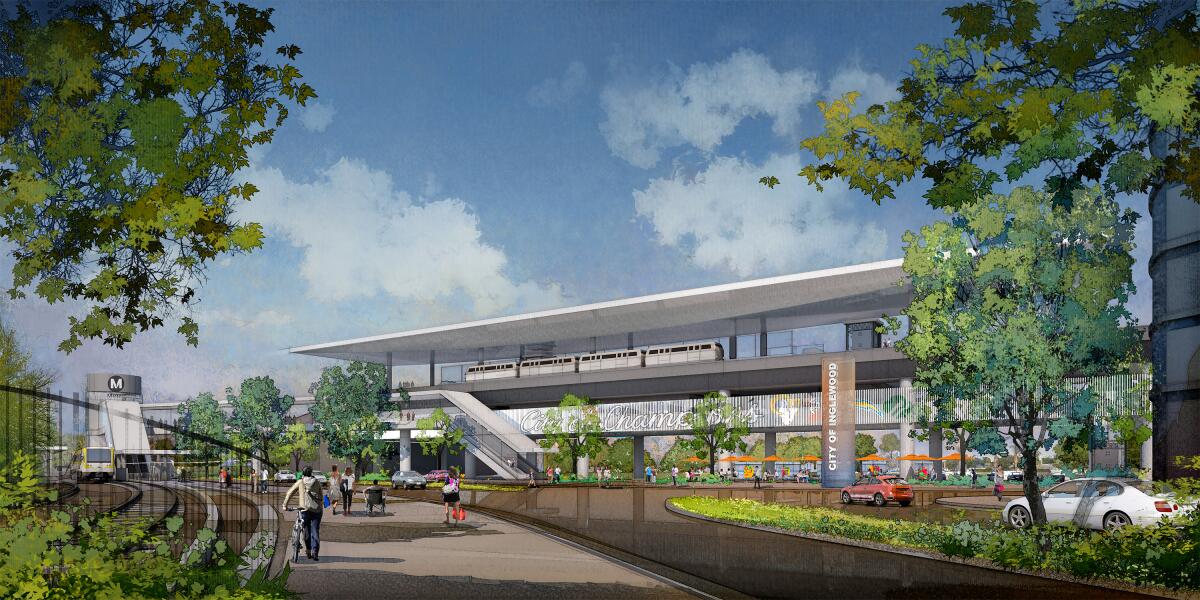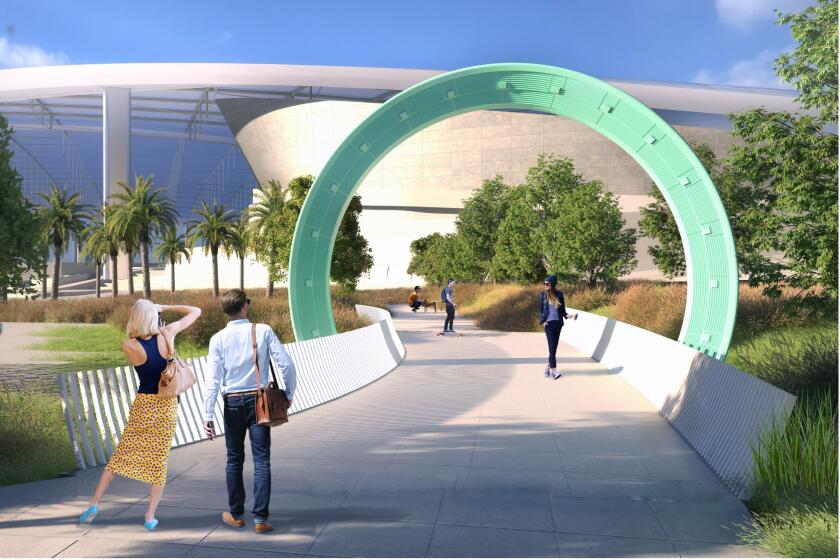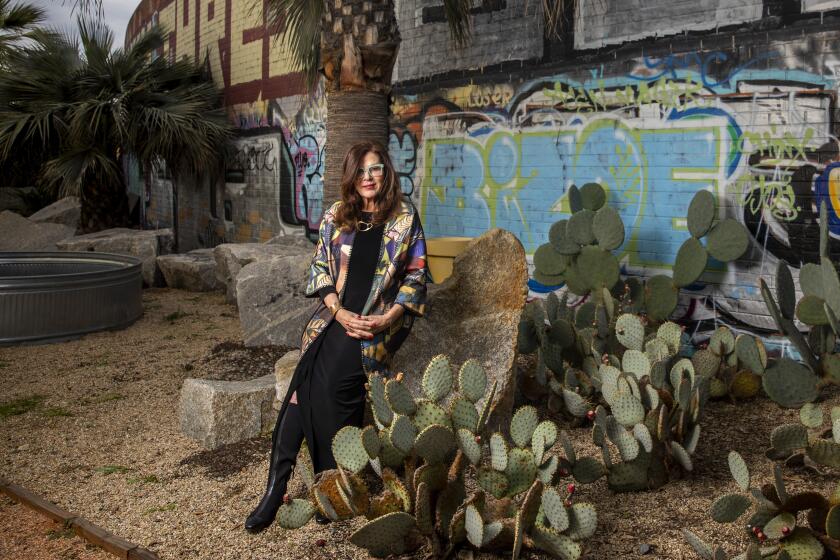Inglewood’s proposed $1.4-billion fix for SoFi Stadium’s traffic problems

Tens of thousands of fans attending the Super Bowl will clog streets and fill $1,000 parking spaces on Sunday at Inglewood’s SoFi Stadium, a scenario that is unlikely to please residents or visitors.
But imagine a train that could drop off fans right in front of the stadium — and is ready in time for the 2028 Olympics.
That’s the pitch Inglewood Mayor James T. Butts Jr. has made to legislators, transit officials and the governor over the last year as he tries to fund a $1.4-billion automated people mover. Butts sees the 1.8-mile line as the key piece needed to turn the working-class community of mostly Black and Latino residents into a thriving global entertainment and sports hub.
The line would connect the yet-to-open Crenshaw line to SoFi Stadium, site of the opening and closing ceremonies in the 2028 Games, and the Intuit Dome, soon to be home of the Clippers. It would also cut across Inglewood’s downtown.
SoFi Stadium is supposed to have a great public art program, but works by Black artists are in limbo. Also missing: the historic sculpture of Swaps, the record-setting thoroughbred from Hollywood Park.
“This makes life more sensible and pleasant,” Butts said Friday. “It is going to cut our emissions. We feel it is going to make us more mass-transit friendly. And we feel it’s going to make our city an example for the rest of the county on how you get people to use the Metro line.”
Inglewood has secured $350 million for the three-station project and aims to approve a final environmental review by the summer, eyeing a 2028 opening. The aggressive timeline is being fueled by anticipation around the 2028 Olympics as funding becomes available and officials across the region race to get costly infrastructure projects finished.
Neighbors now complain that game day brings headaches as fans trample lawns and park along their streets.
“There’s Uber drivers that park in the street and a lot of people walking to the game on my block,” said Brenton Taffe, who lives about a block from SoFi Stadium. “If there’s any reason for me to go out, it’s very disruptive. There’s just congestion. Going to Vons a block away is a 15-minute journey, where normally it takes about three minutes.”
The people mover is intended to ease traffic on game days, when planners estimate it would see about 29,000 passengers.
Critics say the transit line was an expensive afterthought to SoFi.
The $5-billion stadium did not have the environmental review that most large projects in California must undergo. Those studies aim to lay bare the costs of traffic, pollution and noise that can come with a 70,000-seat stadium. Instead the project was approved six weeks after it was announced.
“So we ignored the potential impacts, then we make mitigating the impacts an excuse to spend more public revenue,” said James Moore, director of the transportation engineering program at USC.
Butts dismisses such criticism, saying the stadium and other projects have brought economic development and jobs to the region. To deny those, he said, would have left the community to deteriorate.
He came up with the idea for the elevated train after a study by Metro said it wasn’t financially or technically feasible to add a connector line to the already underway Crenshaw project.
The agency suggested Inglewood take it up and develop a joint powers authority. So Butts helped create a plan through the city of Inglewood.
“He realizes, and we all realize, that if he were to go through the traditional process, developing a plan for a transit line, it would be decades away from being funded,” said Ara Najarian, a Metro board director and Glendale councilman. But going outside the traditional process can lead to a competition with Metro projects also looking for federal or state funding, Najarian added.
Los Angeles landscape designer Mia Lehrer is working to peeling back the city’s concrete. Her latest project brings parkland to SoFi Stadium.
Butts, who last year got the Metro board to agree to lobby federal authorities for funds, has said he is not taking priority status away from projects like the West Santa Ana branch, a $8.5-billion light rail line through Southeast Los Angeles that isn’t expected to be completed until 2043 because of cost.
Instead, he told the board last April that he aims to “create an effort of collaboration and coordination” as part of an overall effort to engage federal transportation officials on funding.
Already Inglewood is undergoing a boom, with several residential and commercial projects underway and housing prices soaring. A new line could mean round-the-clock construction on some of the city’s busiest streets, according to environmental documents. It amounts to a dizzying degree of development for a community of 110,000 people that leaves some longtime residents and businesses behind.
“We are here, but we don’t know for how long,” said Emma Arazola, the owner of Emma’s Snack Shop along Market Street, where one of the three stops would be located. “Two years ago, the owners stopped the lease. I am renting month to month. So, it’s possible at any time that they are going to sell this building.”
But it also means rising home prices for those that have owned for years.
“Gentrification has come,” said Sandra Banks, a 65-year-old resident who lives about a mile from the stadium and is excited about a rail possibly coming to her town. “The whole world is watching. I like football, don’t get me wrong, but this city has changed a lot.”
More to Read
Sign up for Essential California
The most important California stories and recommendations in your inbox every morning.
You may occasionally receive promotional content from the Los Angeles Times.













